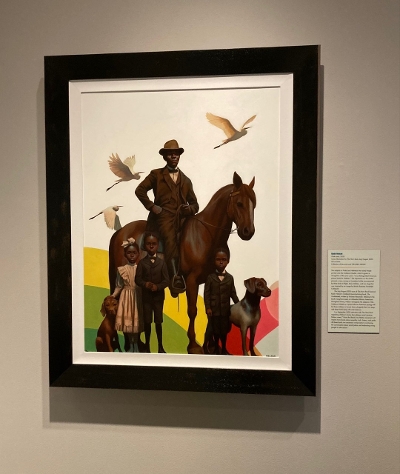Revisiting Kadir Nelson's historic painting, Prideland, currently on view at the Norman Rockwell Museum in Stockbridge, Massachusetts. Why? Because Calling Caldecott readers care about all things Caldecott, including the image on the medal.
 When Elissa Gershowitz visited the Norman Rockwell Museum this summer, she viewed the Kadir Nelson exhibit "In Our Lifetime" (on view through October 30th), which includes the original art for his historic cover of The Horn Book Magazine, created on the occasion of his 2020 Caldecott win for The Undefeated.
When Elissa Gershowitz visited the Norman Rockwell Museum this summer, she viewed the Kadir Nelson exhibit "In Our Lifetime" (on view through October 30th), which includes the original art for his historic cover of The Horn Book Magazine, created on the occasion of his 2020 Caldecott win for The Undefeated.
Former Editor in Chief Roger Sutton wrote about this painting, titled "Prideland," in his July/August 2020 Editorial, calling it "the most radical image...ever to grace the cover of the Magazine." He was right; it is. Why? Well, that's the reason I'm bringing it back to the attention of Calling Caldecott readers. Because we care about all things Caldecott, including the medal itself.
On the physical Caldecott medal is embossed an image (by, appropriately enough!!, Randolph Caldecott, from his book The Diverting Story of John Gilpin) of a man on horseback riding at full gallop, three children, two dogs, and three birds keeping pace in a flurry of movement and urgency and humor. It's a great image, full of action and vitality and narrative; a true storytelling image.

Nelson's Prideland re-imagines the medal's illustration, using the same basic cast: one horse, one man, three children, two dogs, three birds. We see a man astride a horse, but here it's a Black man, the horse is not galloping but standing still, and the man is facing the viewer, though his face is partially obscured by his hat. The man is, as I said, quite still. And yet. There is a powerful sense of as-yet-unleashed movement and potential kinetic energy. One of the man's hands is in his pocket; the other holds the reins, lightly but surely. The man is calm but...ready, alert. The three children gathered around him, dressed in their best, gaze solemnly out at the viewer. Two dogs flank the children, one looking at the viewer like the children; the other looking right. If this illustration were in a book, the dog would be looking toward the page-turn, and thus looking ahead. The birds also fly toward the right — again, toward the page-turn; toward whatever's coming next.
The bands of colors that provide the only background — red, green, and gold — are recognizably the Pan-African colors and add even more meaning to a painting that exudes strength, dignity, and power.

Photo: Elissa Gershowitz.
When Kadir Nelson sent us this image for our July/August 2020 magazine cover, and I realized what he had done, how he had re-imagined the image on the Caldecott medal and made it his own (AND let a lot more child readers feel like it was also now their own), I was blown away. I knew I was witnessing a historic moment in the field of children's literature. Now, when I think of the medal, I see both the original Randolph Caldecott image and the re-imagined Kadir Nelson one in my mind's eye. The Caldecott Medal: it contains multitudes.
ALREADY A SUBSCRIBER? LOG IN
We are currently offering this content for free. Sign up now to activate your personal profile, where you can save articles for future viewing.








Add Comment :-
Be the first reader to comment.
Comment Policy:
Comment should not be empty !!!